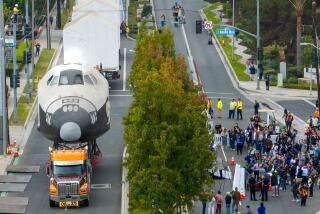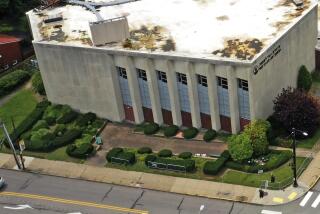‘Space Mirror’ Will Honor Astronauts
Fourteen U.S. astronauts who have died during the space program will be honored by a memorial at the Kennedy Space Center’s Spaceport USA in Orlando, Fla., chosen as result of a national design competition.
The winning design, titled “Space Mirror,” by San Francisco-based architect Holt Hinshaw Pfau Jones Associates, was selected from 756 entries submitted from all over the United States, is a 50-foot wide by 40-foot high granite surface polished to a mirror’s brightness that will track the sun .
The names of the astronauts, grouped by the final mission in which they participated, from Apollo to Challenger, will be cut through the stone. Behind each group of names is a metal mirror which will catch the direct sunlight and reflect the names of the fallen on the clouds.
‘By floating the glowing names against this backdrop, the sky becomes the home for the memories of the astronauts, animated by the sun,” said architect Wes Jones, member of a San Francisco group of young designers, including Paul Holt, Marc Hinshaw and Peter Pfau.
The memorial, sponsored by the Astronauts Memorial Foundation, will occupy a 6-acre site, with a reflecting pool, at the entrance to the Visitors Center. The center, located in a 140,000-acre national wildlife refuge on the Atlantic coast, receives 2.5 million visitors annually. The memorial is scheduled to be dedicated in 1990.
“I think what we found was a very poetic use of technology,” said Chicago architect Ralph Johnson, a competition juror. Other jurors included John Dixon, editor of Progressive Architecture, architect Michael Pittas of Los Angeles, landscape architect Hideo Sasaki of San Francisco, and Alan Helman, chairman of the Astronauts Memorial Foundation.
The AMF, a national nonprofit foundation, was formed in 1986 in response to the tragedy that killed the crew of the Challenger space shuttle.
The foundation’s goal, apart from construction of the Orlando memorial, is to establish an educational program “to broaden knowledge of space exploration and influence young people and develop their curiosity in the field.”
The foundation has raised the $4 million projected cost of the memorial from the sale of commemorative Challenger license plates in Florida.
Pittas explained that the Holt Hinshaw Pfau Jones submission entranced the jury with its unique combination of technological cleverness, married to the use of a traditional material such as granite, often used in memorial structures.
Technologically, the Space Mirror will track the sun with the help of satellite transmissions beamed from the Mission Control Center of the Kennedy Space station, and relayed to built-in receptors.
As it tracks the sun through the seasons, the steel framework that supports the granite will move the large mirror so that it reflects only empty sky, free of glare.
Direct sun will strike only the reflecting metal mirrors behind the granite surface, at the correct angle to light up the astronauts’ names. From dusk to dawn, when sunlight is weak or absent, powerful electric lights will illuminate the names.
More to Read
Sign up for Essential California
The most important California stories and recommendations in your inbox every morning.
You may occasionally receive promotional content from the Los Angeles Times.










